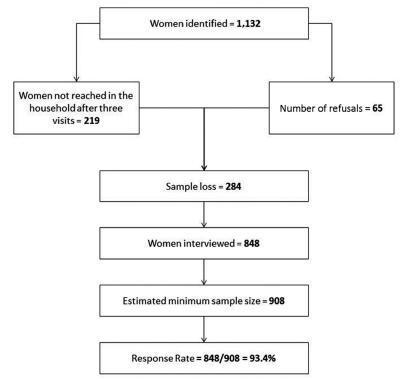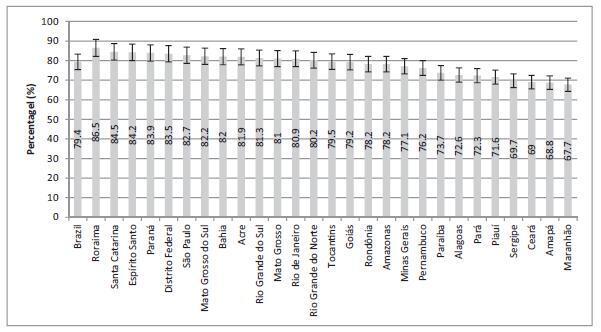Summary
Revista Brasileira de Ginecologia e Obstetrícia. 2017;39(11):587-595
To identify the prevalence of maternal morbidity and its socioeconomic, demographic and health care associated factors in a city in Northeastern Brazil.
A cross-sectional and population-based study was conducted, with a design based on multi-stage complex sampling. A validated questionnaire was applied to 848 women aged between 15 and 49 years identified in 8,227 households from 60 census tracts of Natal, the capital of the state of Rio Grande do Norte (RN), Brazil. The main outcome measure was maternal morbidity. The Poisson regression analysis, with 5% significance, was used for the analysis of the associated factors.
The prevalence of maternal morbidity was of 21.2%. A bivariate analysis showed the following variables associated with an increased number of obstetric complications: non-white race (prevalence ratio [PR] =1.23; 95% confidence interval [95%CI]: 1.04-1.46); lower socioeconomic status (PR = 1.33; 95%CI: 1.12-1.58); prenatal care performed in public services (PR = 1.42; 95%CI: 1.16-1.72): women that were not advised during prenatal care about where they should deliver (PR = 1.24; 95%CI: 1.05-1.46); delivery in public services (PR = 1.63; 95%CI: 1.30-2.03); need to search for more than one hospital for delivery (PR = 1.22; 95%CI: 1.03-1.45); and no companion at all times of delivery care (PR = 1.25, 95%CI: 1.05-1.48). The place where the delivery occurred (public or private) and the socioeconomic status remained significant in the final model.
Women in a worse socioeconomic situation and whose delivery was performed in public services had a higher prevalence of maternal morbidity. Such an association reinforces the need to strengthen public policies to tackle health inequalities through actions focusing on these determinants.

Summary
Revista Brasileira de Ginecologia e Obstetrícia. 2017;39(10):552-559
Resident doctors usually face the task to communicate bad news in perinatology without any formal training. The impact on parents can be disastrous. The objective of this paper is to analyze the perception of residents regarding a training program in communicating bad news in perinatology based on video reviews and setting, perception, invitation, knowledge, emotion, and summary (SPIKES) strategy.
We performed the analysis of complementary data collected from participants in a randomized controlled intervention study to evaluate the efficacy of a training program on improving residents’ skills to communicate bad news. Data were collected using a Likert scale. Through a thematic content analysis we tried to to apprehend the meanings, feelings and experiences expressed by resident doctors in their comments as a response to an open-ended question. Half of the group received training, consisting of discussions of video reviews of participants’ simulated encounters communicating a perinatal loss to a “mother” based on the SPIKES strategy. We also offered training sessions to the control group after they completed participation. Twenty-eight residents who were randomized to intervention and 16 from the control group received training. Twenty written comments were analyzed.
The majority of the residents evaluated training highly as an education activity to help increase knowledge, ability and understanding about breaking bad news in perinatology. Three big categories emerged fromresidents’ comments: SPIKES training effects; bad news communication in medical training; and doctors’ feelings and relationship with patients.
Residents took SPIKES training as a guide to systematize the communication of bad news and to amplify perceptions of the emotional needs of the patients. They suggested the insertion of a similar training in their residency programs curricula.
Summary
Revista Brasileira de Ginecologia e Obstetrícia. 2017;39(10):545-551
To assess the clinical characteristics of subjects with gender dysphoria (GD).
A cross-sectional study of adults with GD. Symptoms of anxiety and depression were measured using the Hospital Anxiety and Depression Scale (HADS). Sociodemographic data, clinical data and life habits were recorded.
Total of 44 subjects participated in the study: 36 (82%) trans women and 8 (18%) trans men. Forty-three (98%) of the GD patients had anxiety (36 [100%] trans women and 7 [87.5%] trans men), and 36 (82%) had depression (29 [80.5%] trans women and 7 [87.5%] trans men). Suicide had been attempted by 32 (73%) subjects. The rates of depression were lower among the subjects living with partners, parents, or other people than among those living alone (p = 0.03), and it was also lower among the subjects who were married compared to those who were dating or single (p = 0.03).
Improving the relationship status may reduce the prevalence of depressive symptoms in GD patients. There was a high rate of attempted suicide in this sample.
Summary
Revista Brasileira de Ginecologia e Obstetrícia. 2017;39(10):534-540
The presence of bacteria in urine is called bacteriuria, which may be symptomatic or asymptomatic. The manipulation of the urinary tract during urodynamic study (UDS), which is an invasive procedure, can result in urinary tract infection (UTI). Studies on the use of prophylactic antibiotics for UDSs are contradictory. Some investigators concluded that they were valuable and others did not. The objective of this study is to evaluate the efficacy of antibiotic prophylaxis before UDS. This is a placebo-control randomized double-blind study.
Two-hundred and seventeen women affected by urinary incontinence were eligible for this study. All patients had presented negative urine culture previous to the UDS. They were randomized in four groups: group A received placebo, group B received 500 mg of levofloxacin, group C received 80 mg trimethoprim and 400 mg sulfamethoxazole and group D received 100 mg of nitrofurantoin. A urine culture was performed 14 days after the UDS.
We observed asymptomatic bacteriuria after the UDS in five patients in group A, one in group B, one in group C and one in group D. Only one patient on group A had symptomatic bacteriuria.We didn’t observe statistical difference between the groups. When we recategorized the patients in two groups, the incidence of bacteriuria was significantly higher in the placebo group compared with the antibiotic group.
The conclusion is that antibiotic prophylaxis before the UDS did not reduce the incidence of UTI in women within the target population.
Summary
Revista Brasileira de Ginecologia e Obstetrícia. 2017;39(10):523-528
To assess cases of labor induction with vaginal 25-μg tablets of misoprostol and maternal outcomes in a tertiary hospital in southeastern Brazil.
This was a retrospective cohort study of 412 pregnant women with indication for labor induction. Labor induction was performed with vaginal 25-μg tablets ofmisoprostol in pregnant women with Bishop scores < 6. Stepwise regression analysis was used to identify the factors present at the beginning of induction that could be used as predictors of successful labor induction.
A total of 69% of the pregnant women who underwent labor induction progressed to vaginal delivery, and 31% of the women progressed to cesarean section. One or two misoprostol tablets were used in 244 patients (59.2%). Of the 412 patients, 197 (47.8%) required oxytocin later on in the labor process, after induction with misoprostol. The stepwise regression analysis showed that only Bishop scores of 4 and 5 and previous vaginal delivery were independent factors with statistical significance in the prediction of successful vaginal labor induction (β = 0.23, p < 0.001, for a Bishop score of 4 and 5, and β = 0.22, p < 0.001, for previous vaginal delivery).
Higher Bishop scores and previous vaginal delivery were the best predictors of successful labor induction with vaginal 25-μg tablets of misoprostol.
Summary
Revista Brasileira de Ginecologia e Obstetrícia. 2017;39(9):488-495
To evaluate the preferences of women and men regarding female pubic hair depilation and identify possible reasons for these preferences.
This is a cross-sectional study of men and women over 18 years old who were invited by the official blog of our institution to respond anonymously to an online and self-administered questionnairemade by the researchers. The analyses weremade using the Statistical Analysis System (SAS, SAS Inc., Cary, NC, US) software, version 9.3, and contingency tables were used to verify the distribution of variables. The univariate statistical analysis was performed using the Pearson chi-squared test, and the differences for values of p < 0.05 were considered significant.
We obtained data from 69,920 subjects (52,787 women and 17,133 men). Themean age was 31.9 years formen, and 28.5 years for women. Most women (64.3%) and men (62.2%) preferred complete removal of female pubic hair, and this preference wasmore pronounced in younger women andmen. Most women reported performing depilation at home (55.8%), with 44.4% using hot wax and 40.1% using a razor blade. About half of the women (44.7%) and men (50.1%) reported sexual activity, having intercourse 2 to 3 times per week. The frequency of intercourse and sexual satisfaction in women correlated with total pubic hair removal.
Most Brazilian women and men prefer the complete removal of female pubic hair, especially those who are younger andmore sexually active.Women who are satisfied with the appearance of their own genitalia have a stronger preference for complete removal of pubic hair.
Summary
Revista Brasileira de Ginecologia e Obstetrícia. 2017;39(9):480-487
To evaluate the coverage of the Papanicolaou test in Brazil and the associated factors.
Cross-sectional study based on data from the Brazilian Health Survey 2013 comprising the proportion of 25- to 64-year-old women who had undergone a Papanicolaou test within the previous 3 years, categorized by sociodemographic variables and access to healthcare services.
The screening coverage in Brazil was of 79.4% (95% confidence interval [95%CI]: 78.4-80.3), showing significant differences between the different states of the country, with the highest rate in the state of Roraima (86.5; 95%CI: 83.5-89.4), and the lowestone in the state ofMaranhão (67.7; 95%CI: 61.3-74.0).Undergoing the test was significantlymore frequent amongmarriedwomen (83.6%; 95%CI: 82.4-84.8), those with higher educational levels (88.7%; 95%CI: 87.0-90.5), of white ethnicity (82.6%; 95%CI: 81.3-83.9) and who reside in urban areas (80.1%; 95%CI: 79.1-81.2). Those who had undergone the test more than three years prior to the survey and the ones who had never undergone it were associated with a lower level of education, being of black or brown ethnicity, single or divorced, and rural dwellers.
The coverage of cervical cancer screening in Brazil is below the recommended rate and presents regional and sociodemographic disparities.
